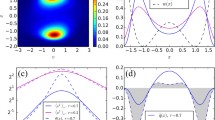Abstract:
We study a model of Brownian particles which are pumped with energy by means of a non-linear friction function, for which different types are discussed. A suitable expression for a non-linear, velocity-dependent friction function is derived by considering an internal energy depot of the Brownian particles. In this case, the friction function describes the pumping of energy in the range of small velocities, while in the range of large velocities the known limit of dissipative friction is reached. In order to investigate the influence of additional energy supply, we discuss the velocity distribution function for different cases. Analytical solutions of the corresponding Fokker-Planck equation in 2d are presented and compared with computer simulations. Different to the case of passive Brownian motion, we find several new features of the dynamics, such as the formation of limit cycles in the four-dimensional phase-space, a large mean squared displacement which increases quadratically with the energy supply, or non-equilibrium velocity distributions with crater-like form. Further, we point to some generalizations and possible applications of the model.
Similar content being viewed by others
Author information
Authors and Affiliations
Additional information
Received 24 November 1999
Rights and permissions
About this article
Cite this article
Erdmann, U., Ebeling, W., Schimansky-Geier, L. et al. Brownian particles far from equilibrium. Eur. Phys. J. B 15, 105–113 (2000). https://doi.org/10.1007/s100510051104
Issue Date:
DOI: https://doi.org/10.1007/s100510051104




